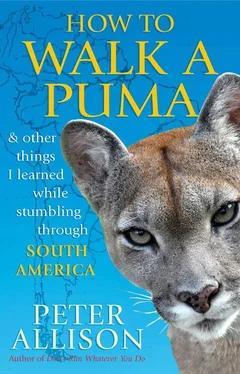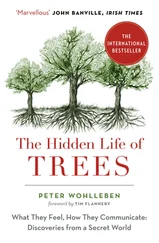That afternoon we made our way back upriver to Otobo’s place by canoe. After a short break we travelled another hour along the river to an even smaller village than Otobo’s. This was the home of a friend Otobo employed to cook for tourists when they came through, who perhaps due to his muscular physique had chosen to go by the Western name of Conan. Many Huaorani used a Western name when dealing with outsiders, perhaps because they couldn’t bear the mangling of their native names. In Conan’s village, I was surprised to meet the man with the clasped hands from our first night, and to learn he was Conan’s brother. He went by the name of Joseph, and was, to his credit, very generous and while he and I practised throwing spears at a banana tree his wife cooked us manioc and fish, served on a palm leaf and eaten with the fingers. We all rinsed our hands in the same tea-coloured water first, and my already queasy stomach initially rebelled. I ate it all though, with a smile as credible as our host’s, and had not a single ill effect afterwards.
I began to change my judgement of the man, as his spear-throwing lesson had been a patient and gentle one, despite my obvious ineptitude. He had also pointed out to me some monk sakis in nearby trees, a beautiful woolly-coated species of monkey I’d only seen once before. Joseph was Huaorani, just different, more exposed to the outside world but retaining a generosity common to them all. Maybe this is what all Huaorani would become as the world closed in, maybe not.
Don’t Let Me Die This Way

The never-to-be defined illness was just part of a catalogue of misadventures I experienced during my time with the Huaorani, but I was still enjoying every day—apart from a moment on the evening after visiting Conan’s village when I almost died.
Earlier that day we stopped at Otobo’s place in Boanamo. I helped unload the boat, hauling seats, tanks of water and gas cylinders up a muddy slope. Suddenly everything wavered and I briefly fainted, something I had never done before. Just as Roy had tried to hide his weakness from me, I didn’t want the Huaorani to see I was still unwell, so popped back up. The Huaorani laughed, not out of malice, but because it was clearly not anything worth worrying about. And because no matter your culture, a man falling face first into mud is funny. So I burst out in guffaws too, until it made me feel woozy again and I staggered on, followed by chuckles.
An hour later I went to bathe in the river, barefoot and wearing nothing but a swimming costume (this was more clothes than I was normally wearing, but I felt it was an important precaution against candiru). Most of the embankments by the river were muddy and any foot traffic quickly turned the ground into the consistency of chocolate mousse. The trail I walked through led to Otobo’s ‘beach’, a sandy patch that only turned muddy once you were ankle deep, meaning that with some tricky foot shaking you could emerge clean.
On the trail a column of ants, maybe twenty wide, swarmed laterally across my path in a hypnotic stripe of constant movement. I hopped over them, identifying them as army ants. These ants are so feared that even a jaguar will walk around them. Army ants don’t look much different to a common garden ant, apart from being slightly larger. Their main difference is the sheer numbers they gather in to launch their marauding attacks, and the columns they travel in. When they fan out in a swarm to forage they devour everything that does not move out of their way, and there are stories of chickens trapped in coops that the ants stripped to the bone in minutes.
The trail of ants doubled back, and crossed the path at another point. I hopped over it again, but soon after the column turned and began to march down the centre of the trail. I waddled along straddling it until it split into two columns, then split again, and I found myself surrounded by multiple lines of ants. Glancing back I saw that the way I had come was now covered, and with no time to think I launched into a run, my tender feet seeking the places with the fewest ants. But the first bites came immediately, causing excruciating pain in both feet, and I broke into a sprint, no longer caring what I trod on.
I would probably have been better off turning back and trying my luck that way. After sprinting for a few steps the world lurched and I felt another faint coming on. I had no time to process the thought, but I instinctively knew that falling here and blacking out would leave me so covered in bites they could be fatal. ‘Don’t let me die this way,’ I thought briefly, recalling stories of elderly people killed because they couldn’t move fast enough. A few more bites and the pain they brought, plus a shot of adrenalin, kept me upright until I was finally past the rapidly expanding swarm, and I threw myself down, my feet aflame as I swatted at the ants digging their mandibles into my flesh.
Standing again, I staggered to the water and flopped in, only to find that the bites had paralysed my feet to a degree but hadn’t deadened the pain receptors, so agony flared anew. Looking back at the river bank, I could see every grasshopper, mantis and other insect capable of flight taking off in waves as they escaped the voracious army. Soon the beach was covered in black bodies. It was only around a fifty-metre swim to another exit point, but my feet were numb and useless for propulsion, the river was filled with snags, and I knew I was prone to fainting. Swimming back was lunatic. Yet I took one more look at the beach and began careful strokes into the current.
Buggered if I was walking back.
•
After what must have been my first booze-free New Year’s Eve in two decades (I was in bed pretty much as soon as it was dark), I spent another feverish night but woke feeling the best I had in some time. So I took a beautiful wooden canoe that was sitting at the village edge filled with water and mud, bailed it out and spent several idyllic hours paddling up the small river that flanks one side of Boanamo before it joins the murky Cononaco.
As I paddled I saw my first ever Jesus lizard, a creature straight out of a cartoon—when startled on the river banks that are its home it rears up on its back legs and whirrs them so fast that it literally walks on water until it reaches safety on the other side of the river. I spent the rest of the day with Omagewe and his wife, who decided to make me some armbands out of palm cotton and strands of Omagewe’s hair that he had crudely hacked off with a knife. To make the armbands she quickly built a loom from kindling-sized branches and the tough aerial roots that the Huaorani use for twine, then threaded the cotton and hair round and through these to make a tight weave. These armbands could be worn for dancing, or just because someone felt like having them on. Omagewe sometimes sported a headband when he set out hunting; apparently it signified a message along the lines of ‘I come in peace,’ should he encounter Tagaeri or Taromenane. This was as elaborate as any clothing went for the Huaorani, and led me to musing about their adoption of Western attire and how they wore it.
A Huaorani fashion parade would be a curious affair. It is only the elderly who regularly dress (or undress, I should say) traditionally, but even Quempere wears a necklace made of red and blue plastic beads interspersed with beads that have random letters of the alphabet he cannot read printed on them. Omagewe walks around in shorts most days, but at home or out hunting he goes naked save the string. One day though he strolled over to me wearing saggy grey underpants so large he had to tuck them into his string, and an oversized fluorescent green T-shirt with ‘Abercrombie and Fitch’ in grand lettering down the side, a fine counterpoint to the Dolce & Gabana T-shirt Bartolo had sported the day before. They are of course cheap Chinese knock-offs and often have misspellings, or whole words missing, so I was really hoping at some stage to come across someone with an FCUK shirt.
Читать дальше













